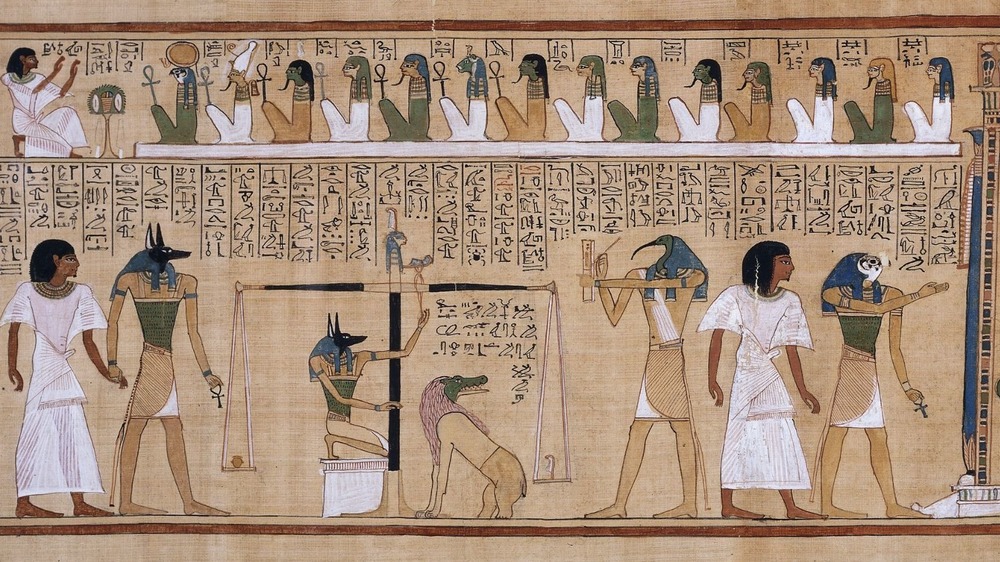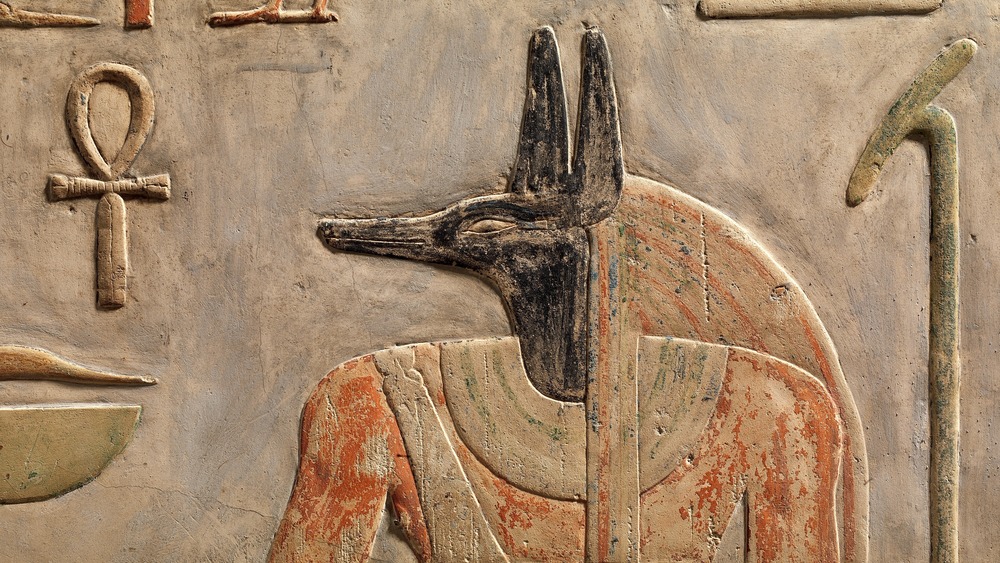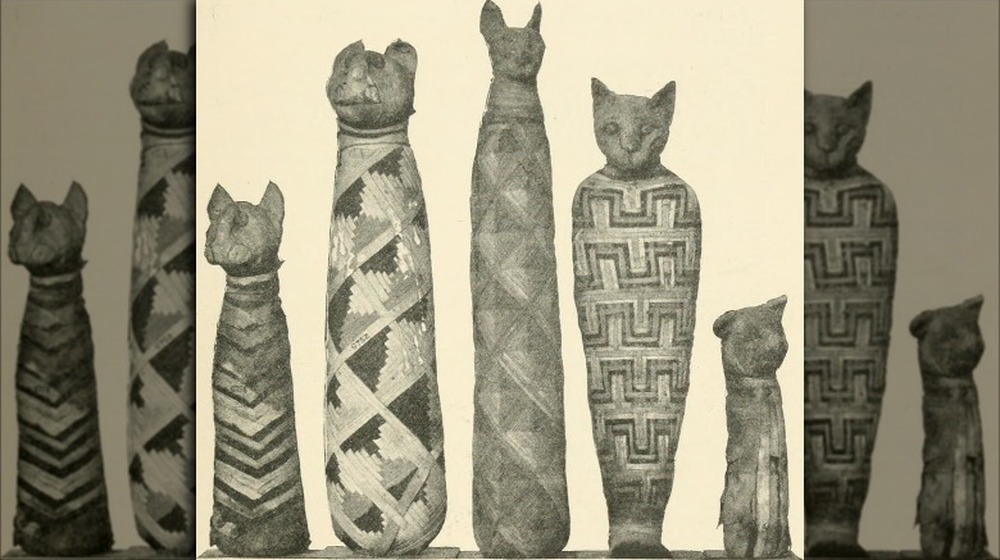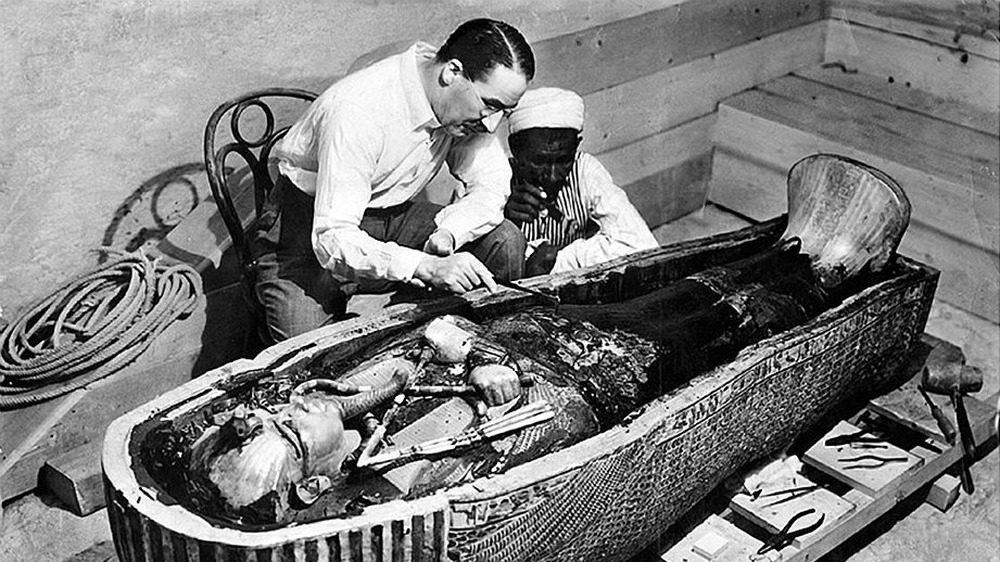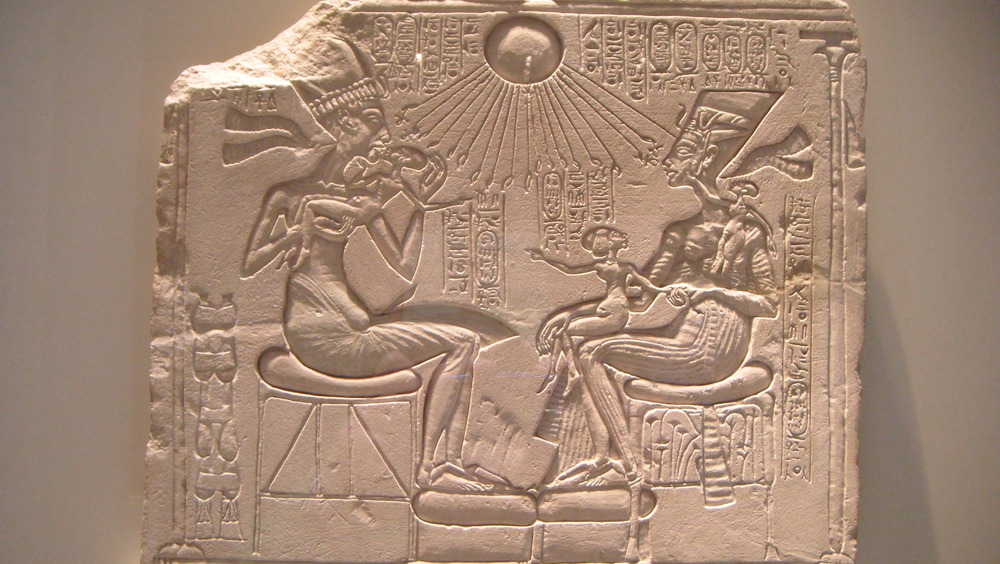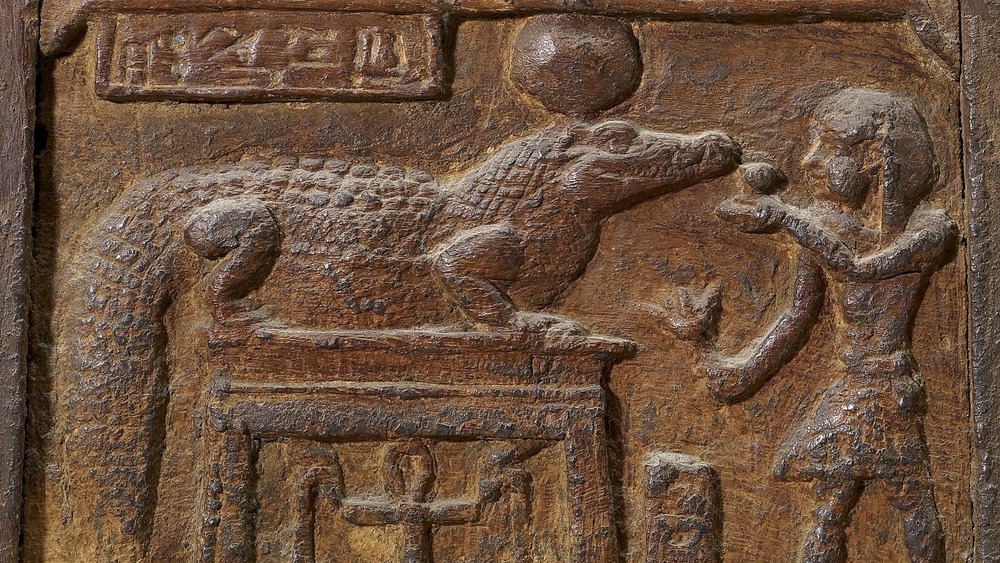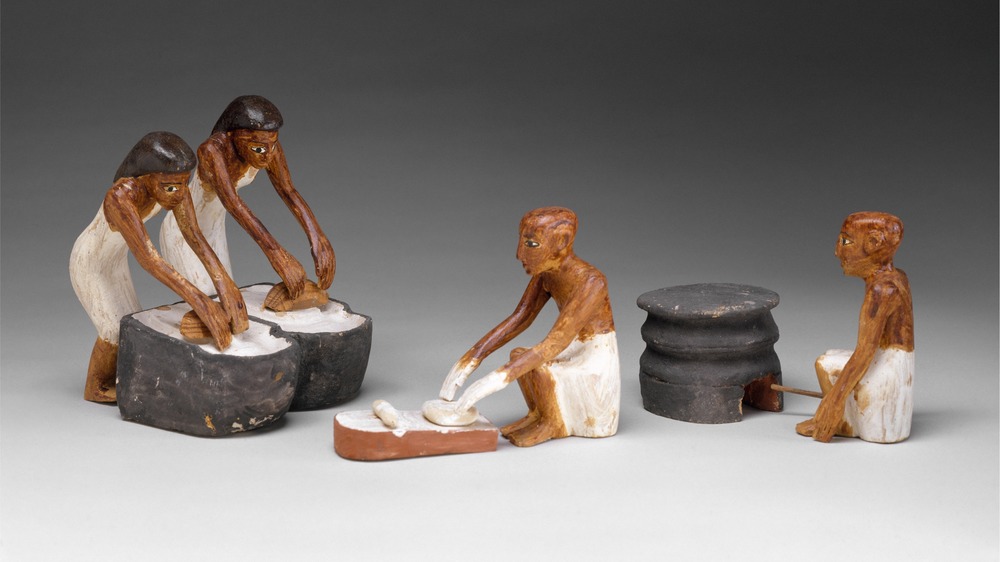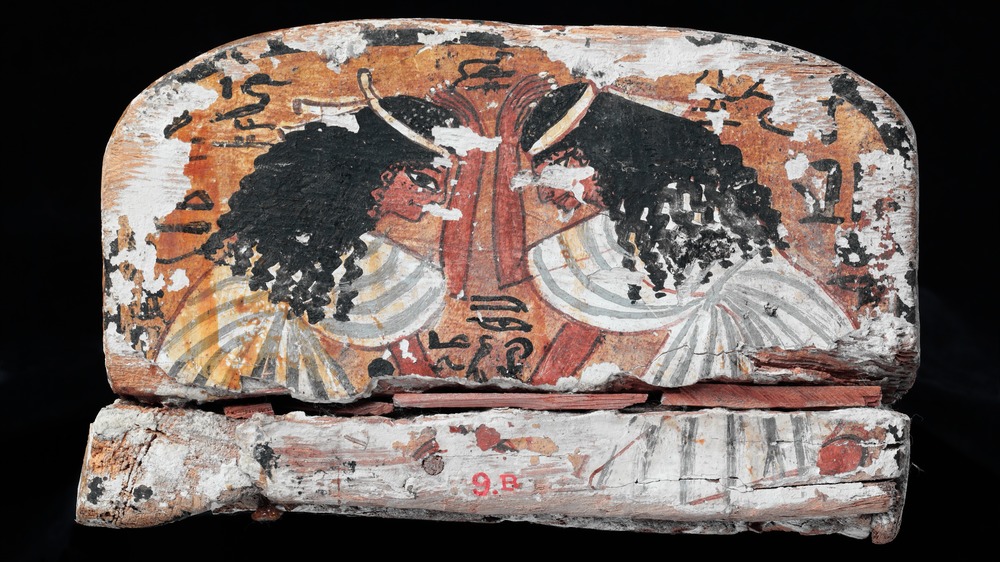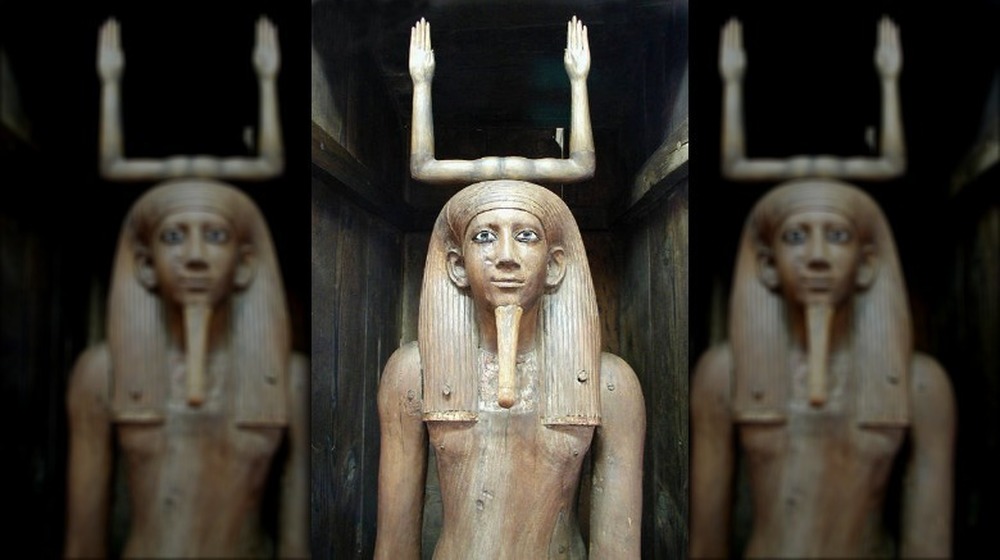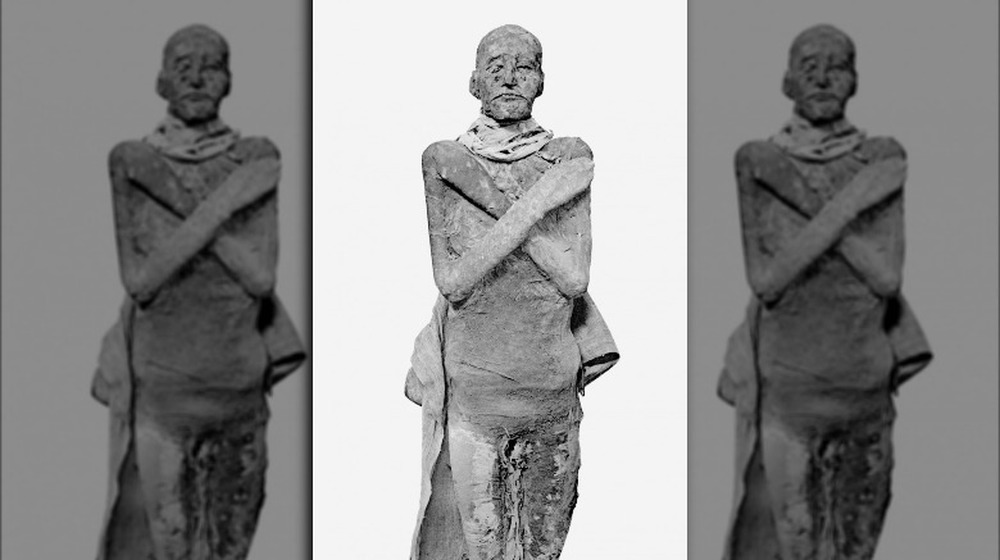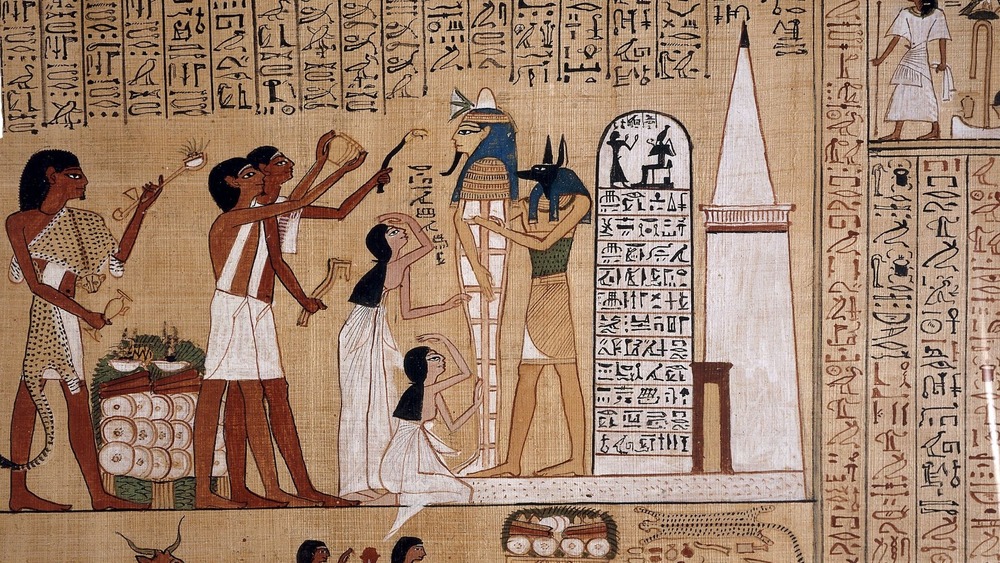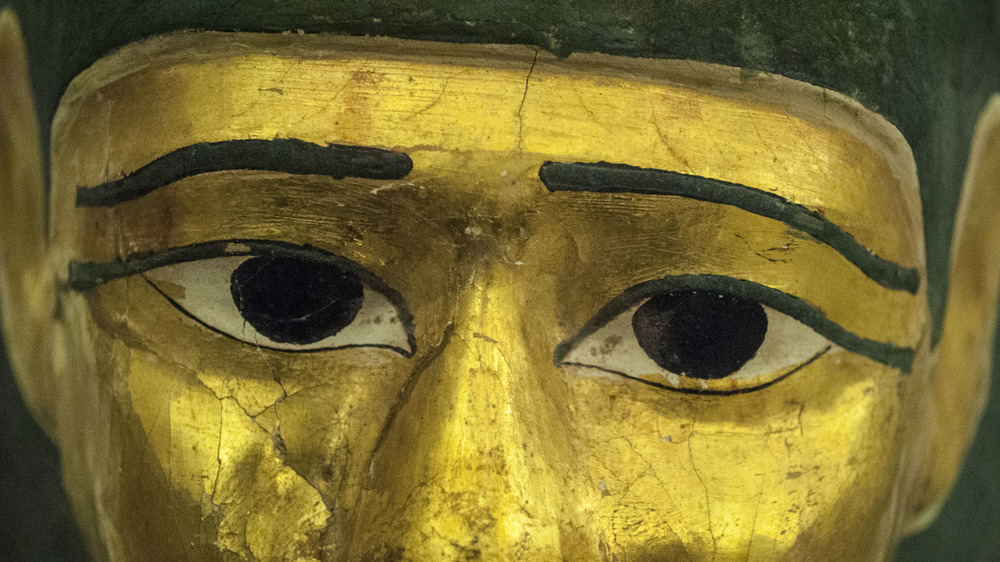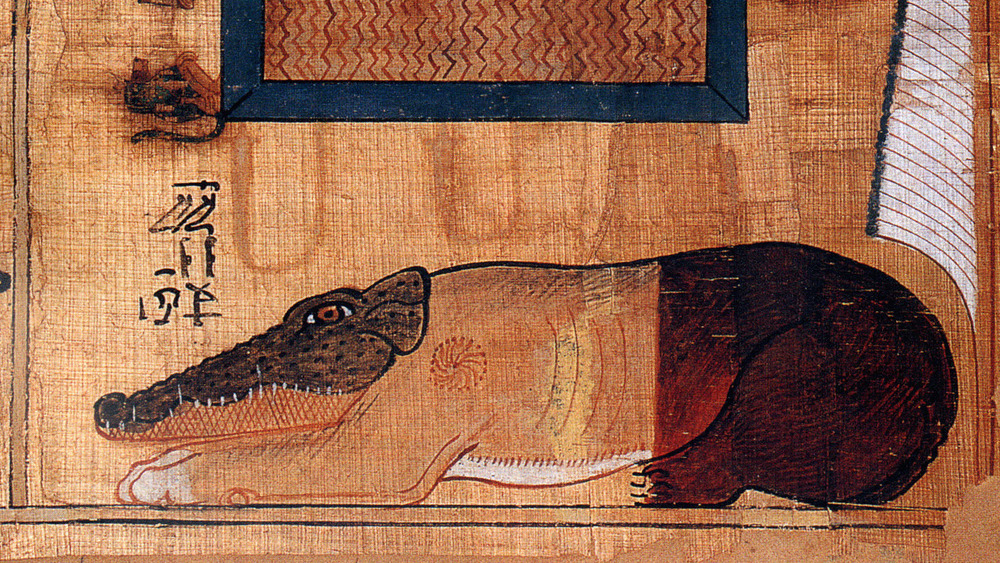Creepy Things You'd Find In Ancient Egypt
In the eyes of quite a few people, ancient Egypt could be a bit creepy. As per History, most scholars agree that ancient Egypt "began" when the fractured lands around the Nile River were united around 3100 B.C.E. and ran, with a couple of significant interruptions, until a Macedonian named Alexander the Great strolled into town with conquering on his mind in 332 B.C.E. However you put it, that's a lot of time for a civilization to develop a set of increasingly complicated beliefs, some of which may put modern folk in an uneasy state.
Of course, classics of ancient Egyptian culture, like animal-headed gods and mummified kings, probably seemed pretty natural and decidedly un-creepy to them. If these practices are raising the hair on the back of your neck, then try to remember that they were considered everyday by a lot of Egyptians. For instance, a mummy was considered necessary for that person's soul to exist comfortably in the afterlife, according to the Smithsonian. Creepy or not, the "double" portion of an individual's soul, the ka, needed to hang around the tomb and receive the (hopefully) perpetual offerings and prayers provided by mourners and priests.
Still, over the course of its long history, the land of the pharaohs came up with a few things that are pretty odd to us today. Here are some of the creepiest things you would find in ancient Egypt.
Ancient Egyptian gods walked around with animal heads
Though ancient and modern religions still associate their deities with animals, few people have taken this idea to quite the extreme established by the ancient Egyptians. Some of their most enduring gods sport animal heads, in enduring and, for some, pretty creepy fashion.
According to the Reading Museum, animals often presented interesting features to the ancient Egyptians. Who wouldn't want to be fearsome like the crocodile, strong like the hippo, or as elegant as a cat? Other creatures, like the maternal cow, were evocative not just of a mother's love but of the romance that would have made her a mother in the first place. It makes sense for animals to be associated with gods, like when, as per Britannica, the fertility goddess Hathor was shown as a divine cow.
Britannica reports that Horus, a sky deity, was frequently shown with a falcon's head atop a man's body. Anubis, who was in charge of everything to do with dead people, sported a jackal's head. Historians suspect that early Egyptians may have seen wild jackals ghoulishly scavenging graveyards, leading to the association between them and the funereal Anubis. Two gods, the ram-associated Amun and the falcon-headed Re, were even combined to become one of the most powerful and widely worshipped deities in later ancient Egypt, known as Amun-Re.
Many gods of ancient Egypt were honored with animal mummies
Like so many other deities in cultures throughout world history, the gods of ancient Egypt needed to be pleased by their human devotees. This included prayers and worship, of course, but also required people to make sacrifices to show that they really meant it when they paid homage to a god or goddess. In ancient Egypt, that often meant mummies.
Because so many ancient Egyptian gods were associated with animals, the mummies in question were actually votive mummies, National Geographic reports. Like their human counterparts, animals were often carefully wrapped in linen, and some even sported gilded embellishments. They might be cats, baboons, birds, fish, entire gazelles, cows, and even tiny scarab beetles. Cuts of meat might be mummified as well, perhaps to act as food for departed humans in the afterlife. However, not all of these mummy bundles are as they seem. Some contain only a jumble of bones, not a whole animal. They might also be poorly mummified or wrapped, indicating that they were the cheap versions of better-prepared mummy offerings.
Animal votive offerings became so popular that ancient Egyptian priests began to manage a cottage industry of rearing, slaughtering, and mummifying sacred animals. According to Nature, close examinations of animal mummies show that many were purposefully dispatched so they could be embalmed and purchased by worshippers.
Some ancient Egyptian tombs really do carry creepy curses
You may have already heard of "King Tut's Curse," the story that anyone who was involved with the 1923 excavation of pharaoh Tutankhamen's tomb was doomed to suffering and death ever after. According to History, that's all nonsense. Expedition financier George Herbert, lord Carnarvon, did indeed die from blood poisoning two months after the tomb's discovery, though archaeologist Howard Carter and others involved in the excavation survived for quite a while longer.
Though the tale of Tut's curse is largely nonsense, there really are some creepy curses written on the walls of ancient tombs. Thousands of years ago, many Egyptians believed that their mummified body was sacrosanct. Any interference with their remains jeopardized their existence in the afterlife, says National Museums Scotland. Though rare, examples of tomb curses or warnings center on this anxiety. One such inscription tells visitors "not to take (even) a pebble from within [the tomb] outside ... beware of forcefully removing this stone from its place."
Business Insider reports that similar curses were put there to ward off grave robbers, an unfortunately common problem. In one burial, a vizier named Ankhmahor tells trespassers that anything they "might do against this, my tomb, the same shall be done to your property." He also threatened to plague them with the "fear of seeing ghosts."
Royal siblings got alarmingly close in ancient Egypt
Many ancient Egyptian royals were pretty concerned about preserving their family lines in order to keep power, money, and divine blood at the top of the social structure. But, how to do this? If you believe that your family and your family alone is descended from Amun-Re, for example, then how can you possibly mix with mere humanity? To keep it all in the family, a significant number of royals married their own cousins and even siblings.
Though this seems shocking in the extreme today, it was a matter of course for ancient Egyptians. It's worth noting that, as the Ancient History Encyclopedia reports, many Egyptians referred to their romantic partners as "sister" or "brother," though this affectionate term did not necessarily mean they were blood relatives. Common folk, it appears, were just fine marrying outside of their families.
However, as University College London points out, there's clear evidence that incest happened in royal households. The mummy of Tutankhamun, the boy pharaoh of the 18th Dynasty, was analyzed by scientists who, upon examining his DNA, discovered that Tut was the product of a brother-sister union. Some scientists believe that this explains a bone deformity in his foot, which would have made walking difficult and perhaps even painful.
These relationships were part of Egyptian religious belief as well. Two of the biggest gods, Osiris and Isis, were said to be siblings who produced the falcon-headed Horus, according to Britannica.
Some ancient Egyptian temples were full of crocodiles
Some temples dedicated to gods also watched over their associated animals. Sometimes, that was meant to create a steady supply of animals to be turned into votive mummy offerings to the gods. Other times, ancient Egyptian priests were tasked with taking care of animals as an act of devotion to their god. This was probably fine for the priests and priestesses to deities like the cat-headed Bastet, but you may have been creeped out by the temple to Sobek.
According to The Washington Post, Sobek was the god of the Nile who sported a crocodile's head on top of a man's body. Some temples dedicated to him also kept real Nile crocodiles, some even with nurseries for hatchlings. Ancient Greek historian Herodotus claimed that some crocodiles were even adorned with jewelry placed by some pretty brave priests. Archaeologists have uncovered evidence that these animals were fed a fine diet, far better than some human Egyptians at the time.
After their death, PBS reports, these crocodiles were also mummified. Archaeologists who completed a DNA analysis on some of these mummies found that they were related to a smaller, more docile species of modern crocodiles, compared to the big, mean ones currently stalking the waters of the Nile.
Early ancient Egyptian servants might be buried alongside their employers
Serving a pharaoh had its perks. A member of the royal household, even if they were working at the command of others, might expect a certain level of security and some decent food on a regular basis. Yet, servants in ancient Egypt's first dynasty might have faced a terrible bargain when their king passed on into the afterlife. You see, he didn't want to go alone.
So-called "retainer sacrifices" only appear to have occurred early in ancient Egypt's history, between 3500 – 2900 B.C.E., according to The Strange World of Human Sacrifice. Some early burials hint that the individuals interred were purposefully dismembered, which would have been an odd practice amongst the early people of ancient Egypt. Some funerary complexes of Egyptian kings, like that of pharaoh Aha, are accompanied by an array of "subsidiary graves," often occupied by young men who normally wouldn't have died of natural causes in such numbers and in such orderly fashion.
Another king, Djer, rested in a tomb surrounded by more than 300 individual burials, reports the American Society of Overseas Research. The practice seems to have faded from there, with subsequent pharaohs buried with fewer and fewer retainers. King Qa'a was accompanied by 26 chambers, some occupied by individual humans, while others appear to have been reserved for grave goods meant for use in the afterlife.
Some ancient Egyptian women worked as professional mourners
Death was a big deal in ancient Egyptian culture. If their families could afford it, individuals would be carefully mummified by professional embalmers. The body was often decked out in amulets and jewelry and installed in a fine sarcophagus before internment in a tomb. High-class people might even have mortuary temples, reports Britannica, where priests would offer prayers and goods to sustain the dead person's soul.
All of this pomp also meant that the funeral itself was a pretty big deal. While some practices that were part of ancient Egyptian send-offs might seem familiar to us today, others could be creepy to modern folk, depending on their culture of origin. According to The Funerary Art of Ancient Egypt, one of the most striking traditions was that of the professional mourner. These were women who were paid to act out extravagant grief. In some paintings, they appear weeping and disheveled, wailing while they touch the deceased's coffin.
Some modern cultures still employ professional mourners. WNYC reports that Hu Xinglian is one of the best-known professional mourners in China today for her crying and shouting at funerals. "Our entry into the world is splendidly dramatic," she said, "so our exit from this world also needs to be spectacular." The ancient Egyptians would likely agree.
Ancient Egyptian magic could get pretty intense
Though other cultures and people throughout history have gotten pretty worked up over things like the occult and witchcraft, it didn't necessarily bother the ancient Egyptians. Magical practice was accepted in nearly all periods of ancient Egyptian history, so long as you didn't try to hurt the wrong sorts of people.
For many, magic was an everyday thing. According to the Ancient History Encyclopedia, magical amulets showing the bearded dwarf god Bes were said to help with fertility and childbirth. His striking face appears everywhere in Egyptian records, from statues, to jewelry, to reports of Bes tattoos, all intended to magically draw upon his considerable power. Bes presumably answered to Heka, the primordial god and force of magic who was so all-encompassing that he never got his own temples. Even then, priests were expected to take on magical rituals and healing practices, too, as Heka was often thought of as a god of medicine.
Rituals could still get serious, with elaborate rituals and accouterments like amulets and protective knives, reports the BBC. Magicians used wax figures, mysterious books full of spells, and even ivory wands. Everyone used magic, from scorpion-charmers who banished the little arthropods from Egyptian homes to midwives helping their clients through the dangerous courses of pregnancy and childbirth.
Harem women tried to kill the pharaoh with magic
The women of Ramesses III's harem orchestrated a successful plot to kill the king, involving not just his bloody murder but a good dose of eerie magic to make the guards look the other way. According to the The Los Angeles Times, the women and men involved in the conspiracy included the pharaoh's second queen, Tiy, and their son, Prince Pentawere. Whoever actually committed the crime must have had a stomach of steel. Ramesses III's mummy shows that his throat was cut so deeply that he died nearly instantly.
The conspirators were found out, however. Ramesses III's successor, who would go on to become Ramesses IV, wasn't especially merciful. According to National Geographic, fragmentary court records from the time indicate that some of the named criminals were allowed to commit suicide, presumably to avoid the shame of a public execution. Historians assume that other unnamed plotters were killed.
It's not exactly known how their lives ended, but one imagines it wasn't very pleasant. Archaeologists now believe that an unusual, poorly treated, and possibly strangled mummy, known as "Unknown Man E" is likely Pentawere himself. The remains were found with the mummy of Ramesses III, but, while the pharaoh's body was in an excellent state of preservation, Unknown Man E seems to have been the subject of a rush job. According to Archaeology, some believe that the mummy may have been handled as crudely as it was because of the prince's treasonous crime.
Ancient Egyptian embalmers had seriously creepy workplaces
For many cultures, working with the dead is eerie enough on its own. Embalmers, who played an important role in preserving a person's remains for the afterlife, had to set aside any qualms and get to work. In fact, those workshops were so well-established that, as Smithsonian Magazine reports, they were comparable to modern funeral homes. One structure, dating to around 600 B.C.E., not only showed evidence of mummification areas but also the existence of burial packages scaled to a family's means.
Herodotus, an ancient Greek historian, described the mummification processes for different social strata. He wrote that, after everyone agreed upon a price, embalmers would take an iron tool and "draw out the brain through the nostrils," after which they would make an incision in the abdomen and "take out the whole contents of the belly" before treating everything with natron, a natural salt. That's what the rich folks got, anyway. Poorer people could expect to have their bodies treated only with cedar oil and natron.
It makes sense that mummification operations had to be aggregated in one place, as even the Egyptians seemed creeped out by the presence of dead bodies. According to History, mummification was also a complicated process that took an average of 70 days per individual, meaning a workshop simply needed space to contain more than one person at a time.
Botched mummifications could lead to restless spirits
Mummification wasn't just a technical enterprise. Ancient Egyptians generally believed that the process was necessary not just to preserve the physical remains of a person but to ensure the continued existence of their soul. That soul, according to the Ancient History Encyclopedia, was known as different aspects like the ka, the shuyet, the akh, and the human-headed bird version known as the ba. To get everything done properly, embalmers and priests needed to say the right incantations and provide the correct amulets to ensure a decent afterlife.
With such a complicated series of tasks, no wonder people sometimes messed up. Yet, as ancient Egyptian legends maintain, incorrectly preserving the dead sometimes meant that they would return and bother the living. Illness and bad fortune could be blamed on the restless dead, who would have to be shooed back to the afterlife by a priest or seer.
One ghost story related in the Ancient History Encyclopedia centers on a man named Khonsemhab, who encounters a spirit by the name of Nebusemekh. The deceased man is upset, as his tomb has collapsed, and no one's bothered to fix it. Khonsemhab, who may have been a high priest himself, reportedly speaks to the spirit and tells the ghost he'll fix everything. The text rather frustratingly cuts off there, but, knowing ancient Egyptian culture and its focus on the afterlife, hopefully Khonsemhab did his duty and fixed up the man's tomb.
The dead feared that the goddess Ammut would devour their hearts
If you happened to be an ancient Egyptian who found themself in the afterlife, you might decide that you have bigger worries than crumbling tombs or slapdash embalmers. As Egyptian beliefs had it, each dead person was to face one final judgment. If they failed this ultimate test, they would be annihilated via the jaws of a terrifying creature.
This was Ammut, who was actually a goddess in most estimations, though she looked very different from the likes of Isis or Hathor. According to The Routledge Dictionary of Egyptian Gods and Goddesses, she's often depicted as a creature with the head of a crocodile, the front of a lion or leopard, and the rear of a hippopotamus. All were fearsome, deadly creatures for living Egyptians.
Ammut waited in the Hall of Truth while the deceased's heart was weighed against the feather of Ma'at, the goddess of truth and justice, as per the Ancient History Encyclopedia. If the person had been good and righteous during their life, their heart was lighter than the feather and they passed on into paradise. If they were wicked, however, the heart would be heavy. It would be tossed to Ammut, who would devour the organ and thus wipe the evil person's soul from existence.
